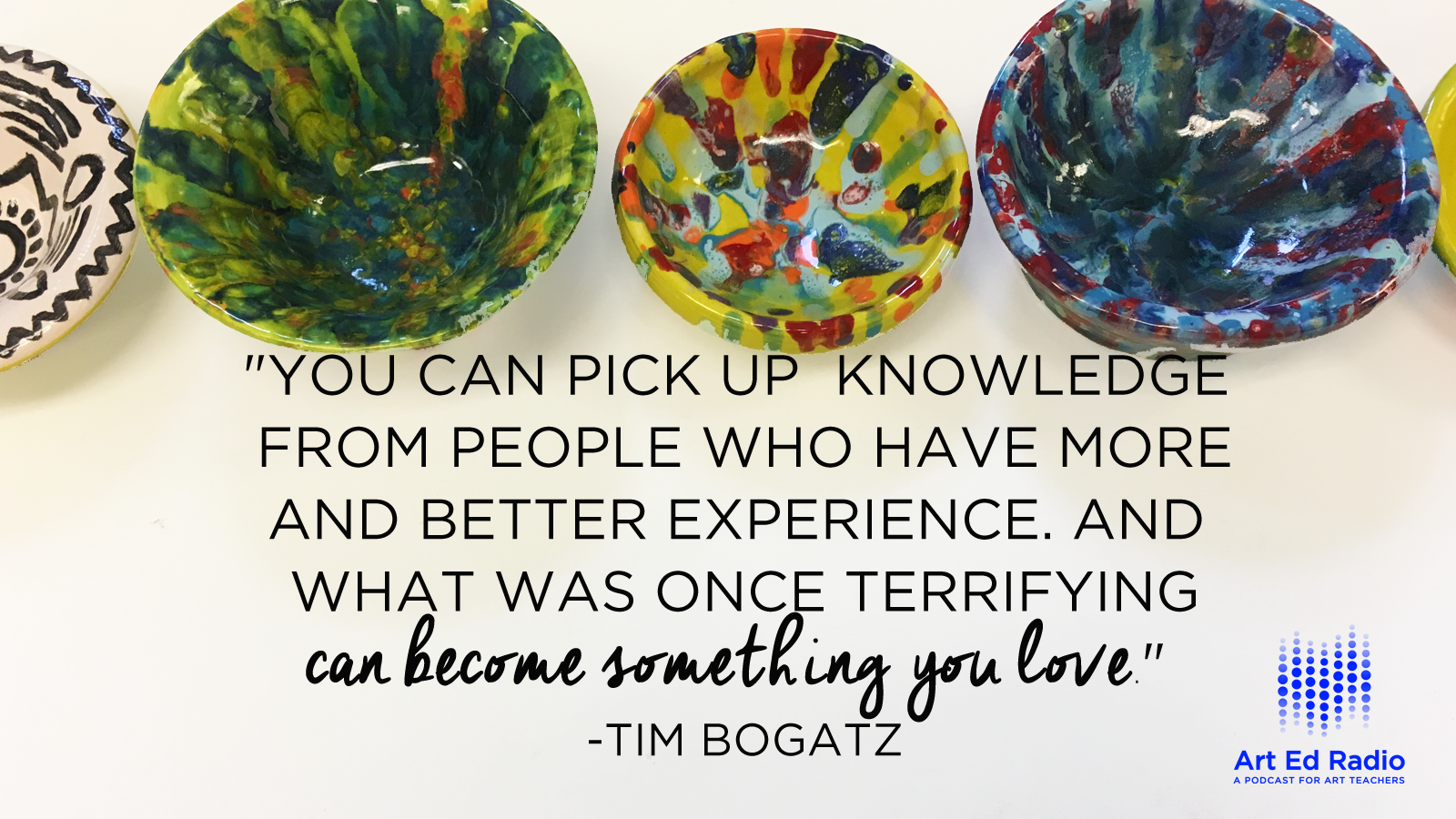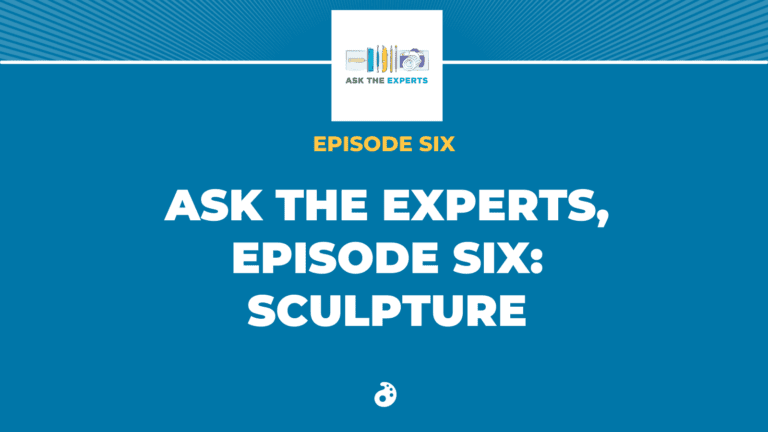So many teachers have a love/hate relationship with teaching ceramics, but the Radio Guys want to convince everyone they can love ceramics like they do. Tim starts the show with a pretty crazy confession about his history with teaching ceramics (1:15). Andrew comes on the show as the guys discuss their favorite homemade tools (5:30), Tim teaches Andrew how to keep his sinks from smelling disgusting (12:30), and Andrew tells about his terrible self-given nickname (15:15) and his best firing processes (16:30). The conversation runs up against the clock, though, so there’s even more the guys need to talk about. Be on the lookout for Part 2 soon! Full episode transcript below.
Resources and Links:
- Tim’s video on using blenders for slip
- How to take your basic ceramics projects to the next level
- 50 Amazing Clay Resources from AOE
- Check out the Studio: Ceramics course

Transcript
Welcome to Art Ed Radio, the podcast for art teachers. This show is produced by The Art of Education and I’m your host, Tim Bogatz.
On The Art of Ed website, we had an entire week of ceramics articles. Just a huge variety of ideas for you, from getting students throwing on the wheel to taking your pinch pots to the next level, to some awesome ideas for using molds and working with glazes at the elementary level. Andrew and I decided that we wanted to join in on that fun. We’re going to be talking today about all ceramics in this episode. We’re going to cover some of our favorite ideas here, both with things we’ve taught in our room and things that we’ve seen other people teach as well. Here’s our thinking, we titled this episode, “Learning to Love Ceramics” because, for a lot of people it’s difficult to enjoy teaching ceramics. There is so much stress with logistics, organization, supplies, clean up, glazing, firing, and on, and on, and on. It really is a lot but, you can get there. Trust me, you can.
Now, I guess that leads me to a little bit of a confession. When I first started teaching, I not only had never taught a ceramics class, but I had never even taken a ceramics class. People worry about teaching ceramics all the time because they don’t have the right experience or they haven’t done it before. Take it from me, you just need to dive in. I really hate to admit this but I went all through high school and then through all of my undergrad without taking a ceramics course. I just love drawing and painting so much in high school that I avoided all the 3D classes that were offered. Then, when I got to college, I took a sculpture class, a performance arts class, all kinds of different things but somehow stayed away from ceramics. Then, when I’m running a high school program, all by myself, I’m just thrown into the fire and forced to learn what I’m doing.
It probably wasn’t the prettiest that first year or the first couple of years, but over time, you just pick up all of these tips and tricks from reading, from experimenting, from just talking to people who have done it before you, and people who have more and better experience. What was once really terrifying, can slowly become something that you love. I’m hoping that this episode can be that for you. A conversation that shares with you some ideas that can make teaching ceramics a little easier for you, maybe a little less scary. Hopefully, you’ll be able to learn to love ceramics as well.
I’m going to bring Andrew on and we’re going to talk about all of our favorite tips, all of our favorite tricks. All of our favorite ideas that can make teaching ceramics a little more enjoyable, a little more worthwhile and hopefully something that’s not quite as scary for you. Joining me now is my favorite co-host, Mr. Andrew McCormick. Are you excited to talk clay tonight?
Andrew: Man, I am super excited. I’ve been that person who used to dread it and I’ve, over the years, gotten better and better at it. I’m happy to share what knowledge I do have.
Tim: I like that. Hopefully, we can have a little bit of a conversation here to get people into your mindset where even if they are a little bit scared, and we can shift that thinking and get them a little bit excited about ceramics. I think the biggest thing for a lot of people, that they’re scared of, is just kind of dealing with organization, right? You have a couple hundred kids that you need to teach clay to, so let’s chat organization.
I think the biggest thing for me is making sure that you have the right tools. I know you like to make a lot of your tools, right?
Andrew: I’ve had to kind of do it out of necessity. I don’t know if I “like” making … I don’t think I like it, but I’ve kind of had to.
Tim: Before we dive into that though, I want to just chat about some of my favorite things. If you do have a little bit better budget, some of the things that you can buy to make your life a lot easier. For me, I love the clay extruder. You can usually get those for a couple hundred bucks. There are some that are table top, some that attach to your wall, but you just put dies in there and force the clay through and you can make coils. You can make all these hollow forms. You can make really cool slabs. You do a lot of really, really cool stuff for that. The other thing that I really like, I don’t know if you’ve ever used one of these, but a slab cutter. Are you familiar with those?
Andrew: I know what they are. I’ve never had the luxury of using one, Mr. Fancy Pants, so no, I can’t say I ever have.
Tim: It works really well and I think a lot of elementary teachers like them because you just get that huge box of clay, you open up the bag and rather than trying to cut all these pieces individually, you can get a slab cutter, which cuts them very consistently, a really nice thickness. You can precut all of your slabs before kids come in. It just saves you a ton of time, ton of headaches. I really like that. Those are my, two, big ones that are semi affordable and really save you quite a bit of time.
Let’s talk though, all those people who don’t have a budget, or all those people who have 43 cents per kid, for the entire year. How do you get into clay tools? What are some of the things that you like, or that you need with your homemade tools?
Andrew: I first got to give a big shout out to John Post, because a lot of my ideas for homemade tools and tips and tricks around ceramics, come from some of his videos and articles and presentations at the AOE conference. I got to joke a little bit because, I made one that was homemade needle tools. Like, if you don’t have needle tools but you want to make some. He does this really nice presentation where he recommends Popsicle sticks, paper clips, some tape, and some epoxy. I made those but man, John, I got to be honest with you buddy. I felt like I had my students making prison shanks. It just looked like we were making homemade weapons.
I discovered that bamboo skewers … You just go to the Dollar General Store, Dollar Tree, or Walmart or something, you can buy bamboo skewers for shish kabobs, they don’t rot, they don’t swell or anything. If students use them and they get wet and dry out. They’re about as sharp and as pointy and gives you that ability to create detail work, as a needle tool, and they cost almost next to nothing. I buy a couple big bags of bamboo skewers and it’s so much cheaper if you don’t have needle tools.
The other one I really like, again, I’m a big fan of going to Dollar Tree, Dollar General Stores, you can buy those cutting mats, for chopping up vegetables and stuff. You can make your own, homemade ribs. You can make just a smooth rib, or you can take the crafty scissors and cut a serration around the top and make some really cheap serrated ribs. I love serrated ribs for scoring, for quickly smoothing out high spots and stuff. Those are pretty expensive, and to be able to make your own, you can buy a pack of three of those cutting boards for $1.00 and each one of them makes like, fifteen. You’re getting like 45 ribs for $1.00, which is awesome.
Tim: Yeah, that is pretty amazing. I used to make them out of old milk jugs. Your gallon milk jugs. You can make ribs out of that as well. Just another option that’s out there for you. Let’s talk organization a little bit too. I know you are coming into a new job. You told me this story before your being gifted with like 2,000 pounds of dry clay. How did you deal with that?
Andrew: There was a lot of cursing. There was a lot of shaking my fists at the heavens. I got a hammer and I started busting it up. It was like it had been thrown in there and it had been congealed together. There was one tote, a big ole, honking tote that most people would store Christmas ornaments and junk in, just filled. Easily this one tote alone was like 500 pounds of dry clay. There were multiple totes like that.
What I discovered, and I did this at my old job too, was, if you can just bust it up a little bit so there’s smaller pieces and you put that in a big ole 55 gallon trash can. A big ole sturdy one that has wheels, like a base that has wheels on it, then you can just let that stuff soak all semester long. You can keep checking on it. The nice thing is, as it’s soaking, the top layer is like slip that you can grab when you’re in a hurry. When you run out of current clay, you can again, take some of that stuff off the top. You’re gonna have to wedge it all up, or maybe blend it up, but you can start reconstituting that stuff. You just can’t afford to let dry clay go to waste. That should never happen.
Those trash cans on wheels, they let you be mobile and move around your clay that you’re letting reconstitute, wherever you need to if you’re limited with space. Yet, they’re also durable. The thing with putting it in a big ole tote … Even a small tote, if you fill that thing with clay, you’re talking at least 200 pounds of clay. That’s not going to be easy to pick up, so having it on wheels is super important.
Tim: I love having the huge trashcan to recycle things because, again, everything can go in there. By the way, kids love getting in there, not every kid, but they love to just roll up their sleeves and just put their entire arm into there to help reconstitute stuff. I just put down a sheet of canvas and just grab a ball of clay out of there. They just turn them so they dry out evenly, then once they’re at the right consistency you can wedge that and it’s usable again. I really like that too.
Two other things real quick. If you don’t have room for a 55 gallon trash can, get a five gallon bucket. Even recycling a little bit of clay at a time will work really well. It takes a little bit of patients but you can have your kids help. A five gallon bucket is not going to take up that much space, so you can definitely do it on a smaller scale. Then, the other thing, as far as organization that I really like is, just having a couple of big buckets in the sink. It almost works as a trap. Having kids wash their hands, or wash their tools, over a bucket before that water gets into the drain of your sink. It works really well to just have kids wipe off all the clay. It sinks to the bottom of that bucket. The water overflows out of the top and goes down into the drain but all of your extra clay stays in the bottom of the bucket so it doesn’t get clogged in your sink. You can also just dump that right into your huge trashcan, wherever you’re reconstituting.
Andrew: I’ve got to ask you a question about that because I feel like I’ve been doing that for a few years. I feel like I must be doing something wrong. I definitely notice I wash a lot less stuff down the drain, I’m not having the clogged drains. I always feel like that bucket just smells disgusting. I don’t know if I need to be dumping it more regularly. After a couple days of that water sitting there and the kids haven’t been agitating it enough, it just smells like sewage water. Am I doing something wrong?
Tim: No. The smell actually comes from any kind of organic material that gets in there. Anything that can be broken down by the clay. If you have a needle tool in there that’s all made out of medal, then you’re probably going to be okay, it’s not going to smell bad. If you get parts of a sponge or something, then the clay’s going to start to break that down. It’s going to grow mold and it’s going to get really nasty in there. Just making sure they don’t have any weird junk in there, is one way to keep it from smelling bad. Then, like you said, if you can just mix it up a little bit more, then that’s always helpful.
Andrew: So, if you have nothing but clay and water and it doesn’t move, that won’t get too stagnant?
Tim: I haven’t had it happen. I mean, it may. it may have weird stuff in the clay itself, I don’t know. We haven’t had too many problems with that before.
Andrew: I must be doing something wrong. My hands must just be filthy dirty with disease and regret or something. I don’t know.
Tim: That’s probably it. We’ve talked about organization a long time, but if we can move on a little bit. The other thing that I see a lot of people have trouble with is firing. Things exploding in the kiln. I just need to tell everybody, do not fire your clay until it is completely dry. I don’t know why people need to rush it. They insist on rushing it and then all of a sudden, everything blows up in the kiln. Like, “I have no idea what happened.” It was still wet, that’s what happened. A good rule of thumb is to press the piece that you’re about to fire, against your cheek or against the back of your hand. If it still feels cold, there is still moisture in there. If it’s room temperature it’s dried out, it’s ready to fire. That’s a really good rule of thumb. I know you, Andrew, want to emphasis the whole idea of being really patient. Can you talk about how your patient with ceramics drying out and with your firing?
Andrew: I had an epiphany a while ago and maybe this will cause a big tadoo in the art ed communities, some controversy. Someone once told me that air pockets are not actually the enemy that we think they are. I always tell kinds if there’s an air pocket or an air bubble in there, where’s the air going to go? It’s going to expand, it’s going to pop. I actually think it’s less that than just the moisture that will get trapped in those. I don’t know if that’s still an open debatable thing, but …
Tim: That’s what I’ve always learned, where air can be a problem, but 99% of the time, it is moisture.
Andrew: Yeah. Because of it being moisture related, you just have to be really patient. Clay shrinks when it dries, so I’ve really stressed to my students, you do not want things to dry quickly. You don’t want things to dry at all while you’re working on them. One of the things I stress is what I call the two bag technique. I like to joke, like, two bags sounds like Two Chains, the rapper. I make my students call me Two Bags McCormick. I don’t know why, but it sinks in when we poke fun of me and call me Two Bags.
I like to wrap one bag, really tight, around the clay, it’s not even around the board, but you spritz down your clay, you maybe add a wet paper towel to it. You take one bag really tight around the form and then one more bag around everything, just for good measure. I feel like, with that two bag technique, rarely, if ever are you going to have air getting in there to dry it out when you don’t want it to dry out.
Conversely, when you’re ready to do a bisk fire, I used to not do this and it was a big mistake I would make. I would just take the kids art work, put on the shelf. We’re drying out. We’re ready to go. Think about any sort of appendage, a horn, a nose, anything that sticks out. Because air can circulate around that much faster, all the way around it. It’s going to shrink faster. It’s going to crack, it’s going to pop, it’s going to want to fall off. What I do is, I tell my students, we’ve got to dry those really slowly and we take one bag and we just loosely drape it over the form. Very loosely so air can filter up through the bottom, get in there nice and slow and gentle. You don’t want them to dry out too fast.
If you do happen to be in a rush, and it’s like, “Oh my gosh”, we’ve got one kiln left to go and it’s all these … I’ve got just one load left to go and there’s a couple that I’m a little questionable about. I’m not embarrassed to say I’ve done all day candles where I just crank open the lid of the kiln, set that baby to 200 for 24 hours and I start putting all the pieces in and I don’t actually let it run for 24 hours, but I’ll start it at 7:00 and I’ll turn it off at 5:00 or maybe start to fire it at 5:00. That sucker candled for like 10, 12 hours and I think that’s really helped out a lot. Once I started realizing that you can candle stuff for a long time to just really take any guess work out of it. If it was wet or dry. It’s really helped me not blow anything up.
Tim: I think that’s a good tip. I love candling also. I think if you have an electronic kiln where you can make the settings, create whatever firing process you want, you need to do a 6, 8 10, even 12 hour preheat, where it is just candling. It’s 180 degrees, just keep it below 212 so the water’s not boiling. Anywhere around 180, 190 is good to go. Just candle it for quite a while. If you don’t have an electronic kiln, what I always used to do is I would just prop the lid open, just a little bit and I would fire it on low all night. Before I left for the night I would turn it on at super low, let it candle all night.
When I came in, in the morning we would ramp up to medium and then ramp up to high. You’re there when it’s firing at it’s hottest. You’re there when it shuts off. That always worked out really well for me. I think it’s a good tip, but yeah, I think that’s the biggest thing when you’re firing, to keep things from exploding, to keep them from blowing up, you really do need to candle. You need to be patient. You need to take it slowly.
We’re running out of time here, so what I’m thinking is, we want to throw a couple more good ideas at people before we leave, and then next week we can come back and talk a little bit more about our favorite projects we like to teach. Some glazing ideas, all that kind of stuff. I know you have one last, really good, hack that you want to share about using the blender. You want to go with that one?
Andrew: Yeah, you want me to talk about this one because I got this idea from you. You want me to stroke your ego a little bit.
Tim: No, I didn’t know you’d stolen it from me, I thought you … I thought it was something you had done.
Andrew: No, I got it from watching you Tim.
Tim: Oh fantastic.
Andrew: You had posted a video on AOE a while ago about making that good slip, and you know that just that right consistency that kids really like. It starts with that 55 gallon bucket, it’s been soaking, it’s been soaking, but it’s still not 100% even. Maybe you had some bigger chunks that aren’t as broken down, but you can take that stuff, put it in a blender, add a little bit of water. It’s trial and error. You just blend that sucker up and it makes like, super smooth, super even slip that … My rule is, if I can pour it into the little dish that’s at every table, I’ve got something good. Kids don’t need to get a special tool, they just dip their finger in, it’s nice and even and they can blend it. It’s really been a lifesaver.
But wait, I want to piggy back onto that. I know we’re running long on time, but I’ve also started experimenting with the apple cider vinegar as a slip. I know I sound crazy but-
Tim: I’ve heard about that but I’ve never tried it.
Andrew: It works. I honestly didn’t think it was going to work. I thought this was some hocus pocus, but especially I’ve had students that have had a piece that was bone dry and “Oh my God, Mr. McCormick, my ear broke off”, or whatever broke off. You just dip a little brush into some apple cider vinegar on both sides, then hold it. Doggone it, the acid content of the vinegar literally melts and fuses the clay back together.
Tim: That’s crazy.
Andrew: I had a girl, just recently, who broke an ear off of this really nice mask that she had made. I did that, and that sucker survived the firing. I was okay, I’ll try this out, I don’t know. We fired it a couple of days later. Here’s the funny thing, me being an idiot, I picked that mask up, kind of by the ear, and then it snapped off after it had been glazed. It had … She had then glazed it, it survived the glaze firing, and I’m holding it by the ear …
Tim: Only to have her teacher break it.
Andrew: Oh my God, it’s the worse feeling in the world. All the kids are looking. I’m like, “Look at this beautiful mask that she made.” Poink … and it just snapped. I thought because it had survived the bisk fire, and the glaze fire, we were in the clear, but I shouldn’t have been holding it by the ear, I guess. I’m here to tell you man, the apple cider vinegar trick totally works. It’s awesome.
Tim: I like it. That’s a good one to go out on. That’s something that I’m going to need to try too. Cool. We definitely need to continue this discussion because I know we have a lot more to talk about. We’ll run this into next week too. It’ll be awesome. Thanks for joining me though. Apparently Andrew and I have a lot more to share than I thought, so we’re going to continue this conversation in another episode. Make sure you check back next week and we’ll talk about everything that we couldn’t quite get to here. We’ll chat about our favorite ceramics lessons, some of our best glazing techniques and ideas. If this conversation is any indication, we’ll talk about a whole lot more as well.
Before I let you go, I need to tell you about the ultimate shortcut for learning how to teach ceramics. AOE’s Studio Ceramics course. If you take this course, you will learn it all in about eight weeks. Through the Studio ceramics course, you experience with all sorts of hands on advanced techniques, using slips, using under glazes, rather unique texture treatments and hand building techniques. You also learn where you can make those historical and interdisciplinary connections with your kids. In this course you’re going to create really useful tools, you’ll create finished pieces for your classroom and most importantly you learn how to break a lot of these ceramics skills down for your students at a level that’s developmentally appropriate for them.
No matter what age you teach, no matter what level you teach or what level you are yourself, you’re going to find a lot of information to help you out when it comes to teaching ceramics. Visit the artofed.com/courses to check it out. There is a new section of the course beginning ever single month. That is going to wrap it up for us. Like I said, make sure come back next week as we dive even deeper into the world of teaching ceramics. Somewhere over the course of all of this conversation, hopefully you can find some ideas that will help you learn to love ceramics as well. We will see you next week.
Art Ed Radio is produced by the Art of Education with audio engineering from Michael Crocker. New episodes are released every Tuesday and you can find all of our archives at artedradio.com. Once you’ve binge listened to all of those, sign up for our email list or feel free to shoot us a message at radioguys@theartofed.com. We always love hearing from you, good, bad, and otherwise. We’re always happy to start a discussion. Thanks for listening.
Magazine articles and podcasts are opinions of professional education contributors and do not necessarily represent the position of the Art of Education University (AOEU) or its academic offerings. Contributors use terms in the way they are most often talked about in the scope of their educational experiences.



